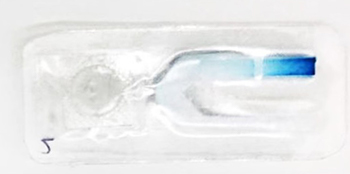Developing a Smart Mask to Surveil Coronavirus
Scientists show feasibility of color-changing device for disease detection
In Brief:
- Researchers from the University of California, San Diego, demonstrated the feasibility of a “smart” mask that captures a wearer’s saliva for disease detection.
- Smart masks could one day be used to alert mask-wearers of a potential infection and the need for subsequent testing, especially in group settings such as nursing homes, rehab facilities, schools, and assembly lines.
The virus that causes COVID-19, known as SARS-CoV-2, has a vexing trait that helps it spread—it can be contagious without causing symptoms. Infected people constantly exhale tiny, virus-laden droplets—largely invisible to the naked eye—that linger in the air all around us, putting others at risk for infection. How can we know if we’re infected or infectious, especially when we feel fine?
To help answer this question, researchers at the University of California, San Diego (UCSD) are working to create a “smart” mask that can detect SARS-CoV-2 infection in the wearer. To make a mask “smart,” the researchers aim to develop a sticker-like test strip that is affixed to the mask’s inner layer and changes color when exposed to virus expelled in the wearer’s saliva or breath. The scientists recently demonstrated the feasibility of this approach in a study published in Analytical Chemistry.
“Masks are like the ultimate wearable sensor, because they are on our body all the time now,” says project leader Jesse Jokerst, PhD, a nanoengineering professor at UCSD. “This sticker could go on any kind of mask you have, and I think that’s very practical.”
The project is supported by NIDCR as part of NIH’s Rapid Acceleration of Diagnostics Radical (RADx-rad) initiative, which encourages the development of nontraditional approaches to COVID-19 testing and surveillance. Postdoc Zhicheng Jin, PhD, and graduate student Alec Jorns, MS, from Jokerst’s lab were co-first authors on the paper.
For the feasibility study, the researchers first wanted to see whether various types of masks can collect enough saliva for detection. They also wanted to determine where test strips should be placed on masks to best capture saliva. In a series of experiments, participants wore four types of face coverings: a neck gaiter, a surgical mask, an N95 respirator, and a cloth mask. The volunteers wore coverings for varying lengths of time and under different conditions, including closed-mouth breathing, talking, and running. By tracing amylase, an abundant enzyme in saliva, the researchers were able to estimate the concentration and distribution of saliva in the masks.
As might be expected, strenuous activity and prolonged mask wearing produced higher concentrations of amylase in the masks. But neck gaiters and surgical masks captured three times more amylase than cloth masks and N95 respirators. The results suggested that neck gaiters and surgical masks have better capabilities for concentrating oral fluids for disease-related detection.
Next, the researchers designed a prototype test strip that consists of an absorbent pad for collecting saliva and a blister pack filled with liquid that, upon release, turns the strip blue in the presence of amylase. The scientists placed the strips in masks that participants wore for eight hours. The team found that the color-changing strips were effective at capturing and detecting amylase from the mask-wearers’ saliva. The results suggest that it is feasible to upgrade everyday masks for disease detection.
The researchers say that their next steps will be to adapt the color-changing strip to detect the main protease (Mpro), a marker of the SARS-CoV-2 virus, and to validate the smart mask in people who have COVID-19. The team aims to create a viral detection tool that is rapid, simple, affordable, and reliable. But Jokerst notes that it is not meant to replace diagnostic testing.
“Our design is more of a surveillance technique; it’s an early alert,” says Jokerst. “It could be a way to prevent outbreaks from getting big in a hurry, especially in aggregate groups of people in nursing homes, rehab facilities, schools, and even assembly lines.”
Related Links
- Coronavirus Sensor Fits in Palm of Your Hand
- Scientists Find Evidence that Novel Coronavirus Infects the Mouth’s Cells
References
Mapping Aerosolized Saliva on Face Coverings for Biosensing Applications. Jin Z, Jorns A, Yim W, Wing R, Mantri Y, Zhou J, Zhou J, Wu Z, Moore C, Penny WF, Jokerst JV. Anal Chem. 2021 Aug 10;93(31):11025-11032. doi: 10.1021/acs.analchem.1c02399. Epub 2021 Jul 26. PMID: 34309356.
Activatable Carbocyanine Dimers for Photoacoustic and Fluorescent Detection of Protease Activity. Moore C, Borum RM, Mantri Y, Xu M, Fajtová P, O'Donoghue AJ, Jokerst JV. ACS Sens. 2021 Jun 25;6(6):2356-2365. doi: 10.1021/acssensors.1c00518. Epub 2021 May 26.PMID: 34038103
Attention Editors
Reprint this article in your own publication or post to your website. NIDCR News articles are not copyrighted. Please acknowledge NIH's National Institute of Dental and Craniofacial Research as the source.
Subscribe for NIDCR Updates
Receive email updates about the latest advances in dental, oral, and craniofacial research.
October 2024



